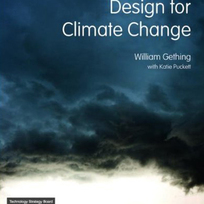We can no longer ignore climate change adaptation

Take a look at Bill Gething & Katie Pucket’s latest publication ‘Design for Climate Change’, launched at EcoBuild 2013 and funded by TSB: it is an essential guide to design and procure sustainable buildings which aim to perform robustly in a future changing climate. The book is accessibly written and well-illustrated and makes a compelling case for adaptation design, while acknowledging the challenges of responding to an uncertain future and that one solution does not fit all. Uniquely, the book unveils a variety of design and modeling tools and presents different approaches and their limitations by reviewing several real-life projects across the UK. Clients, developers, architects and engineers can no longer ignore adaptation issues - neither this significant publication.
After all, the (fossil fueled) energy required to heat, cool, light, ventilate and construct our buildings are responsible for around 50% of the UK’s CO2 emissions. CO2 is one of the main greenhouse gases leading to climate change. While our buildings’ fossil fuel addiction impacts climate, a changing climate also in turn impacts on buildings. It is crucial that our built environment is able to adapt to a changing climate to ensure continued performance and thermal comfort for occupants.
I also briefly touched on this during my talk ‘What we can learn from igloos (+ dispelling environmental design myths) at a breakfast talk at 8am on March 7th at URBANO Network as part of Climate Week.
I also reviewed Huw Heywood's '101 rules for low energy architecture' book here.
I also briefly touched on this during my talk ‘What we can learn from igloos (+ dispelling environmental design myths) at a breakfast talk at 8am on March 7th at URBANO Network as part of Climate Week.
I also reviewed Huw Heywood's '101 rules for low energy architecture' book here.